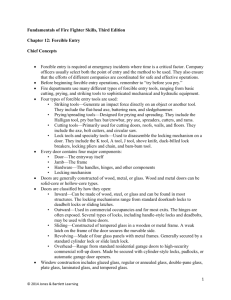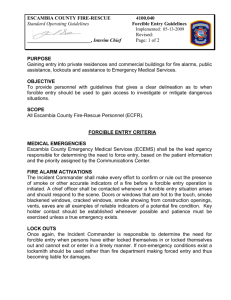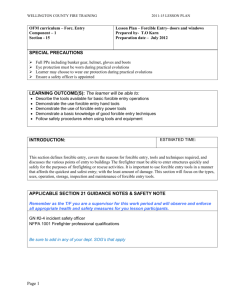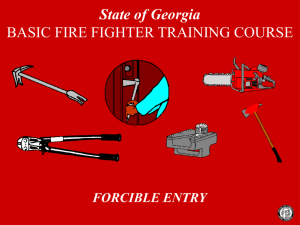Chapter 17
advertisement
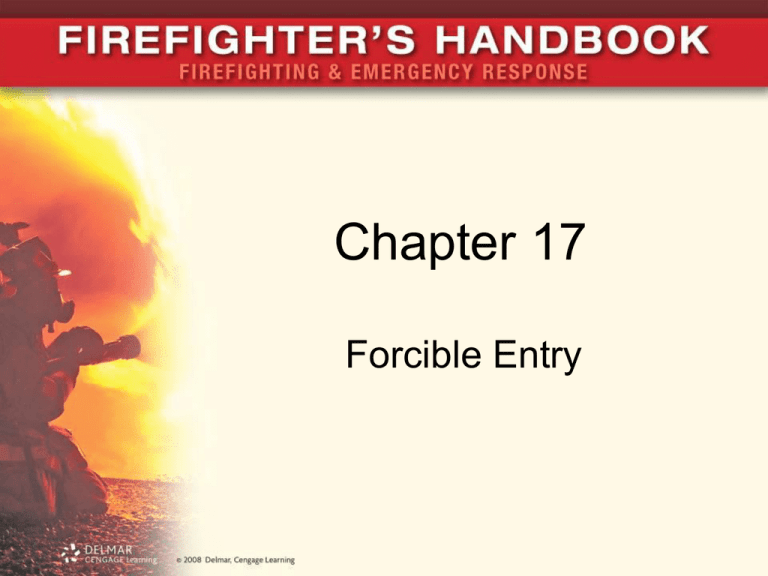
Chapter 17 Forcible Entry Introduction • 2 ½ million homes broken into each year • Owners install a variety of locking devices to protect both homes and businesses • Forcible entry often one of the first operations conducted at a scene to gain entry • Forcible entry is a combination of knowledge and skill – Must have knowledge of building construction and locking devices 17.2 Figure 17-1 A typical assortment of forcible entry tools used by fire departments. 17.3 Knowledge • Working knowledge of locks, hardware, doors, and other assemblies is essential • Must be able to “size up” the quickest and easiest way to gain access • Firefighter must know which type of tool to use and best method to gain access 17.4 Skill • Involves a firefighter’s ability to apply knowledge of: – – – – Building construction Lock assemblies Tools Techniques • Skills developed by repeated practice 17.5 Experience • Acquired by three means: – Drills and practice – Scene of actual fires and emergencies – Learning about others’ experiences through case studies and reports 17.6 Forcible Entry Tools • Selection and right use of the “right” tool are essential • Right tool is the quickest and easiest way to complete operation • Many tools have more than one name 17.7 Table 17-1 Forcible Entry Tools 17.8 Striking Tools • Used to deliver impact to other tools • Used for impact delivery to the lock or the door itself – May force the door or even break it down • Types of striking tools: – Flathead ax – Maul/sledge – Ram 17.9 Figure 17-3 The group or family of striking tools includes the maul, small hammer, flathead ax, and Denver tools. 17.10 Prying and Spreading Tools • Used to spread apart a door, move objects, or expose locking device – – – – – Halligan tool Claw tool Kelly tool Hydraulic spreaders Miscellaneous prying tools 17.11 Figure 17-7 The group or family of prying tools includes the Halligan, claw tool, hux bar, Detroit door opener, pry bar, and hydraulic spreaders. 17.12 Cutting Tools • Cut away materials and expose locking device: – – – – – Ax Handsaws Bolt cutters Power cutting tools—saws Carbide-tipped blades and metal cutting blade – Masonry cutting blades – Chain saws and reciprocating saws – Cutting torch 17.13 Figure 17-10 The group or family of cutting tools includes axes, saws (both power and manual), and bolt and wire cutters. 17.14 Pulling Tools • Hook or pike pole most common • Grouped by type of head and handle length • Used to: – Open walls and ceilings – Vent windows – Pull up roof boards 17.15 Figure 17-15 The most common type of pulling tool is the hook or pike pole, available in various styles and lengths. 17.16 Special Tools • Number of specialized tools available to assist forcible operations: – Bam bam or dent puller – Duck bill lock breaker – K-tool and lock pullers • Most tools used in combination with other tools to accomplish a task 17.17 Safety with Forcible Entry Tools • If misused or used for wrong task, forcible entry tools will create safety hazards • General rules apply to all operations – Always wear personal protective equipment – Follow manufacturer guidelines – Do not attempt to cut material for which a tool was not designed – Tools must be in proper condition – Never use tools alone – Tools should be properly stored and easily accessible 17.18 Rotary and Chain Saws • Remove security gates, barred windows, and overhead doors • These saws present a number of hazards • Firefighters should follow operation and safety guidelines 17.19 Carrying Tools • Many tools have sharp or pointed ends and must be carried safely: – Carry ax with blade away from body – Pointed and sharp end of prying ax carried away from body – With striking tools, head carried close to the ground and not swung freely 17.20 Hand Tools • Constructed of: – – – – Metal Wood Fiberglass Combination of materials • Tools inspected regularly for: – Cracks in the handles – Burrs in the metal – Loose heads 17.21 Maintenance of Forcible Entry Tools • General guidelines – Cleaned and inspected on regular basis – Documentation of tool maintenance is important – Follow manufacturer guidelines for battery-operated tools • Specific guidelines for: – Metal heads and parts – Fiberglass handles – Wood handles 17.22 Construction and Forcible Entry • Type of construction of many different features of buildings must be recognized and understood • Thorough knowledge leads to successful forcible entry operations 17.23 Door Construction • Manufactured in many styles • Door assembly: – Door, frame or jamb – Mounting hardware – Locking device mounted in a jamb, which is rabbeted • Rabbeted jamb milled into the casing that the door closes against to form a seal • Stopped jamb has molding nailed or attached to the casing – Can be removed allowing access to lock assembly 17.24 Figure 17-21 Doors are manufactured in a variety of styles and materials. 17.25 Figure 17-22 The parts of a door assembly. 17.26 Types of Doors • Three types of wood doors: panel, flush, ledge • Metal doors are hollow-core or metal clad • Two main types of glass doors: metal, tempered • Other types of doors: – – – – – Sliding doors Revolving doors Overhead doors Residential and commercial garage doors Roll-down steel doors and gates 17.27 Locks • Locks keep unwanted visitors out of a building • Know types of locks, how they operate, and how to disable them – – – – – – Key in the knob lock Mortise lock Rim locks Tubular locks Padlocks Special locks 17.28 Figure 17-33 The parts of a lock device. 17.29 Figure 17-36 Rim locks (from left to right): a dead bolt, a vertical bolt and striker plate, and a vertical bolt with key cylinder. Figure 17-37 Tubular dead bolts. (Courtesy of Master Lock Company, LLC.) 17.30 Additional Security Devices • Additional security may be simple or complex – Simple example: broom handle in track of sliding door – Complex example: additional locks • Forcible entry team may need to find alternative means of entry or use rotary saw • Obtain unwanted locks and use as training aids 17.31 (A) (B) Figure 17-41 These auxiliary locking devices are usually not detected by the forcible entry team: (A) floor-mounted stop plate, (B) door blocker 17.32 (C) (D) Figure 17-41 (cont’d.) (C) steel bar and brackets, and (D) sliding bolt. Note that the bar and sliding bolt are often homemade devices. 17.33 Methods of Forcible Entry • Three standard methods: – Conventional – Through-the-lock – Power tools • All forcible entry operations must be coordinated with fire attack and ventilation – Lack of coordination may result in rapid fire spread or backdraft 17.34 Conventional Forcible Entry • Old and reliable method • Use of leverage, force, and impact • Primary tools: – Halligan tool – Flathead ax • Accomplish one or more of the following: – Force door away from jamb – Break lock, striker, door, and/or frame – Force the hinges; breach the wall or door 17.35 Through-the-Lock Forcible Entry • Involves attacking the locking mechanism • Remove key cylinder and operate lock with alternative means • Used when entry needs to be gained with damage kept to a minimum 17.36 Operating Lock Mechanisms • Manipulate lock by using proper key tool – Flat steel key – Square key tool • Lock cylinders fall into two categories – Mortise – Rim lock • Correct tool determined by examining the cylinder 17.37 Figure 17-46 To operate the lock, look at the back of the cylinder to determine the right key tool to use. 17.38 Lock Variations • Many locks have a spring-loaded shutter • Rim lock with night latch can only be unlocked from inside • Locks such as key in knob and tubular dead bolts are opened in manner similar to rim lock 17.39 Windows • Many types, architectural styles, sizes, and construction • Windows used as an alternative means of entry • Four construction features of windows: – – – – Glazing Sash Frame Security devices 17.40 Figure 17-51 Windows are found in many types, architectural styles, sizes, and construction. 17.41 Forcible Entry of Windows • Each type of window requires a special technique to force entry • Two general reasons to force a window: – Gain entry – Horizontal ventilation 17.42 Figure 17-52 Use a long-handled tool such as a hook or pike pole to break glass out of a window. 17.43 Glazing • Most common glazing material is glass • Different types of glass: – – – – Regular or plate glass Tempered glass Laminated glass Wire glass 17.44 Types of Windows • Several types of windows: – – – – – – – – Double hung/check rail windows Energy-efficient windows Casement windows Awning windows Jalousie windows Projected windows Fixed windows Bars and gates 17.45 Breaching Walls and Floors • Emergency situations often dictate that walls of structure must be opened • Two main considerations when breaching walls: – Type of construction of the building • Wood construction with lath and plaster or drywall easy to breach • Brick and reinforced concrete require more effort – Tools available • Ordinary hand tools are usually sufficient • Solid masonry may require specialized tools 17.46 Figure 17-54 The firefighter uses an ax handle or Halligan tool to poke through a wall to determine if there are any obstructions on the other side. 17.47 Techniques for Breaching Walls • Different types of walls present new challenges – Breaching wood-framed walls • Avoid area around doors and corners – Breaching masonry walls—block or brick • Without power tools only option may be 12pound maul – Breaching reinforced concrete walls and floors • Most common tool used is the jackhammer • May need oxyacetylene torch – Breaching metal walls • Location of heavy structural members located first 17.48 Techniques for Breaching Floors • Cutting wood floors with a power saw – Rotary saw with 12-inch-diameter carbidetipped blade • Cutting wood floors with an ax – Locate floor joists and cut along joist – Pull up finish flooring to expose subflooring – Make all cuts on subfloor first before pulling up 17.49 Figure 17-56 A rectangle, square, or triangle can be cut, followed by the removal of the finished flooring and the subflooring. 17.50 Tool Assignments • Necessary tools must be carried in with first on-scene and later arriving units • Tool assignments based on: – Occupancy and construction of building – Position or task assigned – Department standard operating procedures (SOPs) or policies 17.51 Lessons Learned • Forcible entry is a key tactic • Must understand tools, equipment, and methods • Teamwork is an essential element • Forcible entry must be done quickly • Firefighter must continually size up buildings 17.52
